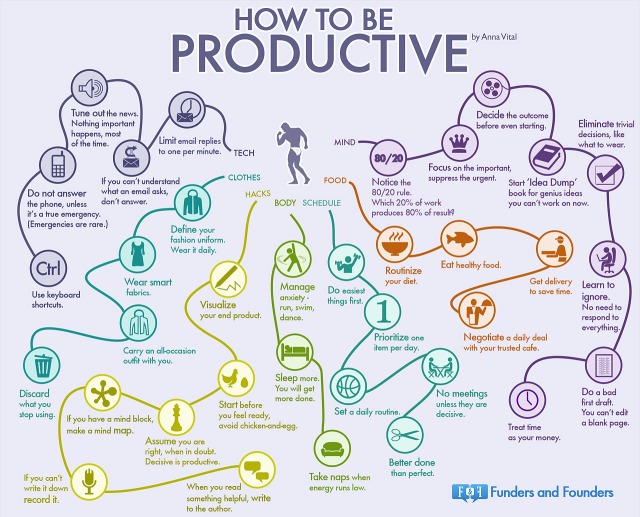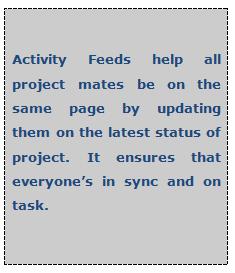Tag Archives: Sanjay Abraham
ED Brill’s (VP IBM) ‘Social Business Transformation’ test
Enterprise Gamification: Motivation works!- RTed by Bunchball and Rajat Paharia

Enterprise Gamification: Motivation works!
How to be Productive

How to be Productive
Driving engagement Loyalty through Gamification.
Gamification is about using game mechanics into non gaming contexts like business processes- to enhance employee productivity, customer retention, partner engagement etc. Gamification is about using game elements & techniques for better engagement. It could help to motivate participation, engagement, and loyalty of any website, social community enterprise application etc.
Gamification Value adds
- Better Engagement, Better sharing & collaboration
- High-value interactions with customers, employees and partners.
- Stronger collaboration, Better ROI, Deeper loyalty,
- Engage employees, partners & customers
Benefits of Gamification
– Stop your communities becoming virtual Ghost towns. Engage better.
– Design process to make product, service, project or business process more engaging, fun, sticky and viral. Make engagement loyalty a success.
– Enhance consumer, partner and fan engagement
– Sales motivation, Social Commerce & Marketing
– Training and learning management
– Recruiting, Referral Programs & Employee onboarding
– Help/service desk efficiencies
– Crowdsourcing content & ideas.
– System adoption etc…and many more!
Poor gamification design could lead to failure. 80% of current gamified enterprise applications will fail to meet their objectives, largely due to poor design (Gartner). So its not just about the platform, the technology, badges or leaderboards but also about a clear understanding of what people want and how the business imperatives could be addressed and driven to success.
I am all pumped up to share more on how gamification could add value into your business processes, communities- the enterprise and enhance the over all productivity of the organization. Let’s clear the farrago and help the enterprise leverage on gamification to enhance engagement loyalty. Am sure the idea intrigues you too. How about giving me a shout?
EFSS- Building a successful content collaboration strategy
Today 50% employees of an enterprise are overwhelmed by content. 70% companies suspect their employees use unsanctioned file sharing methods.
Enterprise File Sync & Sharing (EFSS) is core to any enterprises’ content collaboration strategy.
With the Consumerization of IT and BYOD becoming common at the work place, content sharing with security and compliance is a major challenge. Most of the companies today are haunted by the ‘Dropbox’ problem. Unsanctioned devices and cloud services often put the enterprises at risk.
Limitations of the existing file sharing systems
– Security & Compliance is inadequate. Disgruntled/ rogue users could have copies of sensitive documents on personal devices and use them with vested interests.
– Lack in document collaboration & version control features. There are many versions of the same document present within the systems like email, portals, social media, and other business systems creating lot of chaos & confusion.
– Emails & FTP systems have their own quota limits. Difficult to share large file securely.
– Documents often have lot of meta data (data about documents like when it is created, who owns it, geo-location, track details, speaker notes in presentations etc.) which might not be suitable to be shared outside the company. Existing systems do not keep a tab on metadata and its sharing.
– Customer grade file sharing systems like Dropbox, Apple’s iCloud and Google’s Google Drive (GDrive) lack enterprise features. Can’t address threats caused by users who move data through uncontrolled personal cloud services.
Benefits of EFSS
- Helps in having a single version of truth within a company. Does version control through file synchronization for all users. Checks content overload.
- Reduces physical movement of files. All file access, sharing & syncing happens in a ‘tracked’ environment. Controls data both at rest and in transit. How it is shared and with whom.
- Solves ‘Dropbox’ problem. No unsanctioned devices or cloud storage services are required by employees.
- Removes hidden meta data in documents. So no threat of any sensitive data getting shared with outsiders.
- Encrypted secure transfer for mobile access and initiatives like BYOD.
- Team collaboration and sharing of work using- ‘privileges’, time bound access; conflict resolution. Many people could simultaneously work on same document and any conflict too could be resolved.
- Enables permissions & identity management. Use Active Directory or LDAP for identity management- user authentication & privileged access rights.
- Integrates with existing systems like ECM, WCM etc and becomes the key element of the over all enterprise collaboration strategy.
EFSS could help in having better content collaboration and make the sharing & syncing of files easy, compliant, safe & secure.
Reference Content: Gartner MarketScope for Enterprise File Synchronization and Sharing Feb 2013
I am all pumped up to share more on how EFSS could change the way we work. Let’s clear the farrago and help the enterprise perform to utmost. Am sure the idea intrigues you too. How about giving me a shout?
Social Project Management- Engaging for success
Only 2.5% of the companies successfully completed 100% of their projects- PWC survey on 10640 projects in 200 companies in 30 countries.
Project Management is one of those critical functions which need lot of dedicated efforts across different rungs of the organizational ladder. Success is a function of time and cost and any slip could result in the failure of the project. It’s often surprising that companies follow best practices, use PMBOK®– A Guide to the Project Management Body of Knowledge, have an array of techniques for controlling quality, risk, budget, schedule, and scope,
use techniques like Critical Path Analysis, Planning & Scheduling methods but still projects fail. The reason for project failure could often be attributed to ‘Stakeholders’ disengagement’.
Using Enterprise Social Network, all parameters of project management could be kept in context: Conversations, key deliverables, content/ documents and major milestones. This would help to-
- Collaborate across team (s) to decide on project scope, deadlines and deliverables.
- Delegate tasks and define timelines.
- Coordinate and complete tasks with teams
- Identify issues & solve problems collectively
- Monitor/ Track progress/ and update the tasks to prevent overrun of time & cost. Use analytics, data visualization to get better insight on the project status.
- Less of email ( so less of mess), Fewer project meetings & phone calls
- Ease in locating experts based on skill levels/ on recommendation by others
- Easy onboarding of project members, knowledge sharing & Learning.
- Engage better with teams, partners & customers through vibrant social communities. Use game mechanics for better engagement.
- Content collaboration- Safe, Compliant & secure file sharing & sync (EFSS)
- Enabling Mobility- Project teams have access to project resources on their tabs & Smartphones. Helping in building a mobile workforce which has flexible hours and could freelance.
- Enable innovation through ideation. Crowdsource ideas to get the project done more efficiently.
Social collaboration could help in better project management- reduce cost and time overruns through better engagement, sharing & communication.
I am all pumped up to share more on how Social could change the way we work. Let’s clear the farrago and help the enterprise perform to utmost. Am sure the idea intrigues you too. How about giving me a shout?
————————————————————————————————————————
Sanjay Abraham is an ‘Enterprise Solutions Consulting, Product Marketing & Business Development’ professional. He staunchly believes, ‘Digital Transformation’ could radically change the way business is done today and that presently Enterprises get just 43% value from existing technologies. His areas of expertise & interest include Enterprise Collaboration & Mobility, EFSS, Analytics, Enterprise Social- Social Business, Social Intranet, Social Onboarding, Social Communities, Enterprise Innovation Management, Social Product Life Cycle Management PLM, Social Project Management, Gamification & Engagement Loyalty. Sanjay holds a Bachelors in Engineering (Computer Science) and a PG Diploma in Business Management. He has worked with top names in the IT sector like Avaya GCL & Mahindra Satyam. His client list includes top bracket names across Banking, Insurance, Retail, Telecom, BPO/ITeS, Public Services and other verticals. His contact coordinates are:
Linkedin:in.linkedin.com/in/sanjayabraham. Twitter: @asanjay100 email: abraham@ctprd.com
Driving “People Excellence” through Social Onboarding
Any company trying to compete must figure out a way to engage the mind of every employee– Jack Welch
People are the most valuable asset of any organization. There could be buildings, machines, assets worth millions of dollars but if the right talent is not available, organizations could never scale the pinnacle of success. “Talent shortages” takes priority over “operational execution” reveals a recent survey involving 780 CEOs. Today, any initiative around people excellence is no more a cost item, its survival.
For any enterprise, addressing the people’s issues is of prime importance because it directly impacts its performance and growth. ‘People Excellence’ department is always on a quest to make employee’s performance optimal so that every employee is able to contribute his maximum to the organization. Inspite of such sincere efforts, the culture, practices & technologies used within the organization often hinder performance. Organizations make massive investments in building HR policies & systems but a shouting contrast to it is that the manpower still remains largely untapped.
We could use some ludicrous euphemism- but reality is work still sucks!
IDC estimates that the average worker spends up to 35% of their time just looking for information. 89% of new hires say they don’t have the optimal level of knowledge to do their job. The typical mid-level manager takes 6.2 months before they start to add more value than they have consumed. What a waste!
Initial 45 days are critical for any new Hire. This is when 1/3 of the employee-churn happens. The cost of losing an employee is 3x the annual salary. Traditional onboarding adds lot of chaos to work. The induction program organized for new hires does not add much value. The new hires are bombarded with dozens of PowerPoint presentations in the 3 days program and are then expected to understand all of it and start performing next day onwards. When asked for more information they get numerous email forwards which only fill their inboxes up. When they need experts help, it’s really hard to find any.
If we have the right digital transformation strategy, we could barrel through all employees related problems. A better way of onboarding could be the social way by building strong internal employee communities. The employee could join a group relevant to his role & his interests. The news feeds give him constant updates on the activities taking place on a project, event or topic. Experts are added to the group where they could collaborate with the team, share ideas, best practices and the entire team could be in sync. Views/ comments could be corroborated & fast actions could be taken. Eventually, the load of unwanted emails is eased, there are lesser numbers of meetings, less time wasted and productivity shoots up.
Let’s accept the fact that the days of ‘9 to 5’ jobs are over. Employees today want more flexibility at work. Millennials who use Smartphones & Tablets at work want a more flexible & freelancing work environment. No wonder 60% of them are leaving their companies in less than three years. A recent ‘Millennial Branding’ report also found that 45% of millennials will choose workplace flexibility over pay. It’s a radical shift in priority. So what we see written on the wall is, it should not be just about how much time an employee spends in the office but how much value add he does. Unlike the baby boomers, the millennials don’t mind taking work along on their smart devices. For them there is a thin line between their personal & office lives. In order to ensure longevity of today’s ‘thumb-typing’ workforce its important to make work more engaging, mobile, increase freelancing & make work hours flexible.
61% of CEOs worldwide say that Innovation is a primary concern within their business according to PWC. Where from these ideas for innovation come? Social could provide a platform for Ideation too where employees could share ideas on policies, projects and other topics of interests. Innovation often comes out of ideas of normal employees NOT always the top bracket. Crowdsourcing of ideas could help a lot in making better policies, products and contribute into over all organization’s growth.
Social Onboarding could improve employee productivity & reduce churn through better collaboration, sharing & communication.
I am all pumped up to share more on how Social onboarding could change the way we work. Let’s clear the farrago and help the employees perform to utmost. Am sure the idea intrigues you too. How about giving me a shout?
sure the idea intrigues you too. How about giving me a shout?
————————————————————————————————————————
 Sanjay holds a Bachelors in Engineering (Computer Science) and a PG Diploma in Business Management. He has worked with top names in the IT sector like Avaya GCL & Mahindra Satyam. His client list includes top bracket names across Banking, Insurance, Retail, Telecom, BPO/ITeS, Public Services and other verticals. His contact coordinates are:
Sanjay holds a Bachelors in Engineering (Computer Science) and a PG Diploma in Business Management. He has worked with top names in the IT sector like Avaya GCL & Mahindra Satyam. His client list includes top bracket names across Banking, Insurance, Retail, Telecom, BPO/ITeS, Public Services and other verticals. His contact coordinates are:
Linkedin:in.linkedin.com/in/sanjayabraham. Twitter: @asanjay100 email: abraham@ctprd.com
Microsoft’s Nokia buy out- just another damp squib?
Two slipping companies which were considered to be leaders in their own fields have now become one! Microsoft’s has recently acquired Nokia for a whopping $7.2 billion.
Remember the days when software just meant Microsoft and Mobile just Nokia. That was how these two brands monopolized their markets. It was an expected move as Nokia had already made a move from its Symbian OS to adopt Windows Mobile. While many of the industry experts are gung-ho about the deal, many are criticizing it. There are many apprehensions. Microsoft’s share prices too went on a down spiral the day the deal was inked. How would this association take off? Would it add any value to the industry or its just another damp squib as Microsoft earlier too had made a move to get into the smartphone market through Surface Tablet which was a notable flop. Are there some solid reasons which could have prompted this deal? Yes.
Today Microsoft is at a rickety 4% growth rate and Nokia is left far behind by companies like Samsung . Its not just due to the features and user ‘friendliness’ of the Samsung devices but the large pool of Google’s Android based apps which are available for the users. Google has very smartly nurtured the Android developers community and today its a big driving force. Remember the days when Microsoft launched Windows Operating system and changed history for ever. The Apple’s Macintosh was left behind for Microsoft was much more developers friendly. Seems as if history is repeating itself.
The drivers which could catapult Microsoft to the top in the smartphone industry are as follows…
Smartphone revolution in emerging geographies
New geographies like India, other South Asian countries, Africa etc. are still getting ready for the big smartphone revolution. 3G & 4G are just getting introduced to the market and the potential of these markets is huge. Most of the Asian countries still have decent Nokia presence. Products like Nokia Lumia are getting good customer response. Microsoft could leverage on the existing market share of Nokia to grow it further.
Leveraging on the combined strength of Hardware & Software
The reason for the success of Apple’s products is because it controls & has ownership of both- its hardware and software. Now on Microsoft and Nokia would have the liberty develop better products for the customers and they don’t have to rely on outsiders.
Leveraging on Microsoft’s Enterprise Applications strength
There wont be a single enterprise in this world which would not be using any Microsoft product. Products like MS Office, Microsoft based LoB, MS Dynamics, Sharepoint, Windows based client & server applications, applications built on VB, .net and other software platforms, collaboration tools like Yammer…Microsoft has a deep seated presence in the IT ecosystem.
Today a big challenge with Enterprise Mobility is how to enable mobile access to enterprise applications. People today not only want to access emails, messages etc but also want to access their LoBs and other software on their smartphones. Here Microsoft could have a a major advantage for being an incumbent in all top customer accounts.
This could open new frontiers for mobile application integration, enterprise mobility and collaboration. Developers will again embrace the new platform which has best of hardware and software. Think of the value the users will get.
If Steve Balmer could make it happen then this deal would be considered one of the smartest in the history.
The key business drivers for Enterprise Mobility
One of the key focuses of CIOs today is to try and adopt Enterprise Mobility in their organizations at the earliest.
Big question is…Is mobility really going to change the way business is done. Will it radically improve the performance of the employees. Is it a fab or fad? There are still many doubts about the real value-add enterprise mobility would bring for enterprises.

Lets identify the key factors which are driving it today.
Consumerization of IT
We know, today it has become easy to choose & own technology. Solutions like storage, LoB apps, analytics, collaboration etc, which were considered to be costly are available on the cloud today at a very low subscription fee or even free. Employees often use such services to store & access content on their mobile devices often putting the enterprise at risk. Does the Enterprise have any control as to which and how these apps are used?
Consistent brand experience on mobile devices:
More than 78% of the US Facebook users access it on mobile. Customers today want to have all the features they have on their laptops to be present in their tablets and smartphones too. A major challenge before the enterprises is how to provide a seamless, consistent & continuous brand experience. Using Social, Location & Mobile, the customer could have more fulfilling experience when he browses and buys on his mobile device.
Making Enterprise Applications available on Mobile devices
Today employees want to do real work on their smartphones & mobile devices. User wants to access the his LoB applications & core business systems like ERP, CRM etc. on his mobile. He also wants do necessary analytics, access dash boards, data visualizations, reports etc too. How to integrate mobility with Enterprise Applications is a daunting task before the enterprises. Most of the mobile apps ( for enterprise software) available today are quite poor as they are just a watered down version of the original software. They are not optimized or tuned to access on mobiles.
BYOD ( Bring Your Own Device)
Employees today use multiple devices at the workplace. Tablets, Blackberry, Smartphones…all these are used to access corporate resources from anywhere. These devices have mobile platform which are diverse too like Android, Symbian, Blackberry, Microsoft Embedded, Windows phone etc. How could these devices be used as an integral ‘device fleet’ to get work done smoothly, is a real big question.
Enterprise mobility management helps BYOD programs become successful by providing features like device enrollment for employees to use corporate content & other resources ( based on his role & group) with his one or more devices. Using self service portal on the device employees could manage their profiles, passwords etc. Enterprise risk could also be mitigated with every device accepting terms & conditions/ access policy.
Better security & privacy policy using Containerization
The corporate resources have to be secure and employees privacy should also be respected. The success of BYOD program depends much on how smartly containerization is done while deploying mobility. Researches say that most of the employees save corporate data on personal device and personal data on company’s device. This is a real threat for the safety and security of both employees and the company.
Mobile Content Management (MCM)
Ensuring secure content collaboration on mobile is a business imperative. With BYOD and consumerization of IT there is whole new focus on how to make the content share process smarter and secure.
Enterprise File Share & Sync (EFSS) products are rapidly getting into the IT ecosystem of the enterprises. Such software enable latest version of the document be available across the enterprise and on different enrolled devices. Also the content is encrypted and secure both at rest and in transit. Similarly employees too could share their content with others in a secure environment. Access of content has to be as per the policy of the enterprise, if found to be compromised or misused, access could be denied and or content could be wiped off.
Mobile Device Management ( MDM)
Think about the difficulties, IT department has to face while dealing with hundreds of devices of different types.
MDM could help in better management of devices through ‘common console’, where new devices could be added/ deleted and access rights of the employees could be modified. Directory services through LDAP integration could create role based groups so that the device could accesses the right content. It could also provide various dashboards and log reports for better control & management of the device fleet.
Enterprise Mobility is significantly changing the business world by making the lives of the people easier and enhancing their productivity. Bygone are the days when work was limited to the workstations and there was no work outside the cubicle. Today work moves with the employees in their mobile devices. Enterprise mobility is making it possible in a big way.



